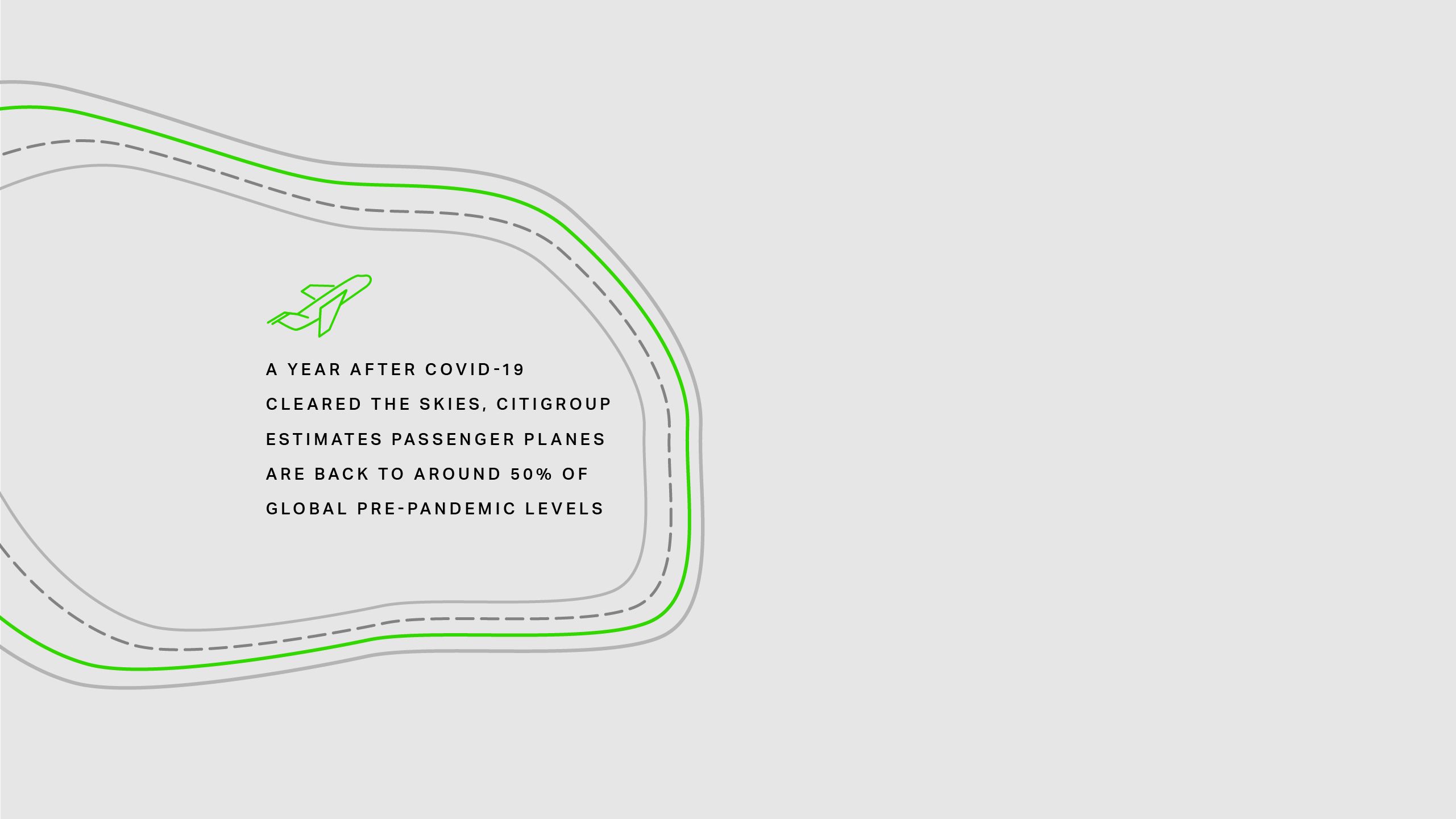Airline Trends in
Emerging Markets



A year after COVID-19 cleared the skies, Citigroup estimates passenger planes are back to around 50% of global pre-pandemic levels1. There are signs of recovery, but they are still embryonic – airlines are beset with border closures, government regulation and other measures to curb infection. Emerging markets are often struggling more, with many regions constricted by lagging vaccination rates.
COVID-19 is also accelerating trends that were already there, like digitalization and the phasing out of less efficient aircraft. Across the globe, many airlines are taking this time to rethink business models and plan for a stable long-term recovery.


Business Travel - Will It Ever Be the Same?
Following the success of virtual meetings, demand for business travel is taking longer to recover and may never be the same – it is instead leisure travel, which looks set to power the recovery.
This is a problem for carriers traditionally dependent on business customers, and for many airlines – particularly in certain emerging markets – now is the time to make changes. Long-haul flights have been particularly supported by business travellers, who are often happy to pay a premium for nonstop flights. Meanwhile, flights with stopovers are more appealing to leisure travellers – especially if they are cheaper. The near future may see more airlines working together to break up long-haul flights into shorter, more sensible routes.
Budget airlines are placing a growing pressure on larger national carriers. The likes of Air Asia and Latin American carrier Volaris have a particular advantage in the current short-haul leisure market.
McKinsey & Company suggests now is the time for airlines to start considering changes to networks and fleets2. Before the pandemic, many added flights between hubs and smaller cities, to accommodate business demand – typically using smaller planes. Long-haul networks may now involve more larger planes, which fly less frequently. This shift could also help to lower carbon emissions.


Business Travel - Will It Ever Be the Same?
Following the success of virtual meetings, demand for business travel is taking longer to recover and may never be the same – it is instead leisure travel, which looks set to power the recovery.
This is a problem for carriers traditionally dependent on business customers, and for many airlines – particularly in certain emerging markets – now is the time to make changes. Long-haul flights have been particularly supported by business travellers, who are often happy to pay a premium for nonstop flights. Meanwhile, flights with stopovers are more appealing to leisure travellers – especially if they are cheaper. The near future may see more airlines working together to break up long-haul flights into shorter, more sensible routes.
Budget airlines are placing a growing pressure on larger national carriers. The likes of Air Asia and Latin American carrier Volaris have a particular advantage in the current short-haul leisure market.
McKinsey & Company suggests now is the time for airlines to start considering changes to networks and fleets2. Before the pandemic, many added flights between hubs and smaller cities, to accommodate business demand – typically using smaller planes. Long-haul networks may now involve more larger planes, which fly less frequently. This shift could also help to lower carbon emissions.

Less Government Backing
Government bailouts supported many airlines during the pandemic. Aside from the Middle East, however, these have been less forthcoming in emerging markets – particularly Southeast Asia and Latin America.
Without government support, many airlines have had to borrow significant amounts to keep going – turning to credit lines, bond issuances and other private means. The global industry accumulated more than $180bn debt in 2020 – more than half of all the money it made that year – and levels are still rising. Where the government backing took the form of debt or ticket prepurchases, this also added to the debt burden of the airlines.
Better performing and better structured airline businesses were in a strong position going into the pandemic. Some have responded to the crisis by restructuring to create more efficient, viable businesses, while others have taken a more short-term approach. Others are evaluating potential value maximizing consolidation. Airlines that fail to make the right changes now are less likely to survive in a post-pandemic market.



Green Shoots and Leaner Businesses in Asia
There are hopeful signs for Asian airlines as countries like Malaysia begin opening up again. Regional air travel is not expected to seriously pick up until 2022, when vaccination rates are higher, however, and long haul’s return is further away.
Airlines that acted quickly to address their financial troubles are now in a much stronger position as a result. Malaysia Airlines was one of Asia’s first airlines to successfully restructure in March 2021. In September, Thai Airways International posted its first profit since COVID-19 hit, following a $12.9bn restructuring.
Many businesses are using restructuring to make dramatic changes. Philippine Airlines’ plan looks towards a leaner, better structured business, reducing the fleet by a quarter. Garuda is currently exploring its strategic options and in discussions with lessors.



Green Shoots and Leaner Businesses in Asia
There are hopeful signs for Asian airlines as countries like Malaysia begin opening up again. Regional air travel is not expected to seriously pick up until 2022, when vaccination rates are higher, however, and long haul’s return is further away.
Airlines that acted quickly to address their financial troubles are now in a much stronger position as a result. Malaysia Airlines was one of Asia’s first airlines to successfully restructure in March 2021. In September, Thai Airways International posted its first profit since COVID-19 hit, following a $12.9bn restructuring.
Many businesses are using restructuring to make dramatic changes. Philippine Airlines’ plan looks towards a leaner, better structured business, reducing the fleet by a quarter. Garuda is currently exploring its strategic options and in discussions with lessors.

Using U.S. and UK Restructuring Frameworks
Many emerging markets’ airlines are using U.S. and UK bankruptcy frameworks to restructure debts.
Philippine Airlines’ $2bn Chapter 11 restructuring is moving quickly so far, and supported by most lenders, lessors, and aircraft and engine suppliers, as well as its majority shareholder3.
Having access to a restructuring process like the U.S. Chapter 11 is a significant advantage for airlines, as it allows them to renegotiate midlife leases and shed excess debt. Use of Chapter 11 has been particularly common for Latin American airlines, which often hold assets in the jurisdiction. With certain exceptions (e.g. for certain government-owned companies), Chapter 11 is available to non-U.S. debtors so long as they have a principal place of business of principal assets in the U.S. In the case of airlines for example, this can often be satisfied by the presence of bank accounts or flight operations in the U.S.
U.S. Chapter 11 affords debtors numerous benefits, including protection under an automatic stay which prevents creditors from taking enforcement action against the debtor while in Chapter 11.
Upon a Chapter 11 filing, management remains in place and in control of the debtor’s operations. In addition, under Chapter 11, debtors can reject or renegotiate executory contracts.
Since aircraft are often leased, this allows international airlines in Chapter 11 to rationalize their fleets by rejecting or assuming unexpired leases and purchase agreements with aircraft manufacturers and vendors that are subject to U.S. jurisdiction, or one that has recognized the U.S. proceedings, with the resulting claims generally considered pre-petition unsecured debt. Finally, Chapter 11 affords enhanced protection to lenders that finance the debtor in bankruptcy through “debtor-in-possesion” or DIP financing.
LATAM (represented by Cleary) and Aeroméxico (in which Cleary represents affiliates and funds managed by Apollo as DIP lender) are progressing well with their Chapter 11 and both are close to final stages. With its $1.6bn Chapter 11 close to complete, Avianca is in merger talks with Sky Airlines, in a move which would create Latin America’s largest budget airline.
Malaysia Airlines used an English scheme of arrangement and Garuda has announced plans to do the same. Schemes of arrangement present an effective way to restructure airline debt, given their simplicity and flexibility. If a scheme receives the support of the statutory majority of creditors and is sanctioned by the English court, the scheme will be binding on all creditors, even those who voted against it.
In June 2020, the UK introduced the restructuring plan as a further tool for companies seeking to restructure their debt. Under the restructuring plan process, a dissenting class of creditors will not necessarily have a veto, while under a scheme of arrangement it would. Shortly after the plan’s inception, Virgin Atlantic Airways became the first company to use the new restructuring plan process to pursue a solvent recapitalisation of its business.
A recent case (Re gategroup Guarantee Limited) which classified the restructuring plan as an insolvency proceeding under the Insolvency Regulation and the Lugano Convention may not be helpful for airlines down the line. Given significant similarities in the definition of the Cape Town Convention and the Lugano Convention, the restructuring plan may well be considered insolvency proceedings under the Cape Town Convention and the Aircraft Protocol.
The repercussions may include the need to obtain consent of each creditor to modifications to a CTC qualifying agreement affecting the cramdown provisions of the restructuring plan. This does not appear to be a concern under the ordinary schemes of arrangement. While no firm decision has yet been made, the judgement in Malaysia Airlines’ recent scheme indicated that there is a powerful case for concluding that the Cape Town Convention does not apply, which should provide airlines with some reassurance.
Aircraft Leasing
The pandemic has caused rents to drop considerably, and even though there are signs of the market coming back, the pre-pandemic rates may not return for a while and even if they do, not for all types of aircraft. As carriers optimise their fleets, lessors must stay one step ahead – ensuring their stock reflects clients’ needs in a market set to fluctuate over the next few years.
Global aircraft leasing’s highly concentrated nature, where a handful of key players manage significant airline portfolios, has created significant financial vulnerability as lessors found many of their key clients were suddenly unable to pay. The pandemic could be consolidating the business further. The $30bn merger between market leaders AerCap and General Electric’s leasing business (GE. N) in March 2021 was followed by Carlyle Aviation’s purchase of Fly Leasing a few months later.
Despite its short-term difficulties, the future could belong to global aircraft lessors, which already control 40% of the world’s passenger fleet. AerCap and JP Morgan have predicted this will rise to more than 50% within the next three years. Leasing supports leaner, more flexible business models, which are an advantage in the current market flux. The growing push towards tech and digitalisation (a trend accentuated by COVID-19) also shifts the needle towards lessors – the industry collectively manages nearly 60% of all delivered new technology fleet4.

Aircraft Leasing
The pandemic has caused rents to drop considerably, and even though there are signs of the market coming back, the pre-pandemic rates may not return for a while and even if they do, not for all types of aircraft. As carriers optimise their fleets, lessors must stay one step ahead – ensuring their stock reflects clients’ needs in a market set to fluctuate over the next few years.

Global aircraft leasing’s highly concentrated nature, where a handful of key players manage significant airline portfolios, has created significant financial vulnerability as lessors found many of their key clients were suddenly unable to pay. The pandemic could be consolidating the business further. The $30bn merger between market leaders AerCap and General Electric’s leasing business (GE. N) in March 2021 was followed by Carlyle Aviation’s purchase of Fly Leasing a few months later.
Despite its short-term difficulties, the future could belong to global aircraft lessors, which already control 40% of the world’s passenger fleet. AerCap and JP Morgan have predicted this will rise to more than 50% within the next three years. Leasing supports leaner, more flexible business models, which are an advantage in the current market flux. The growing push towards tech and digitalisation (a trend accentuated by COVID-19) also shifts the needle towards lessors – the industry collectively manages nearly 60% of all delivered new technology fleet4.

A Green Transition?
A growing focus on efficiency and cost should inevitably make air travel more sustainable. Heightened regulation and growing consumer concern (both intensified by COVID-19) are also creating a greater impetus for airlines to build greener business models. Green debt also remains highly popular in the market, at a time when many airlines still have pressing financing needs.
Etihad Airways announced in October that it had raised $1.2bn in global aviation's first sustainability loan, linked to environmental, social and governance goals. It also runs the Greenliner programme, which uses its Boeing 787 Dreamliners’ fleet to test sustainable flight initiatives.
Airlines are accelerating their climate goals by committing to net-zero carbon emissions by 2050. Rolls-Royce, Shell and Airbus have also called for airlines to transition more quickly towards sustainable aviation fuel (SAF).



A Green Transition?
A growing focus on efficiency and cost should inevitably make air travel more sustainable. Heightened regulation and growing consumer concern (both intensified by COVID-19) are also creating a greater impetus for airlines to build greener business models. Green debt also remains highly popular in the market, at a time when many airlines still have pressing financing needs.
Etihad Airways announced in October that it had raised $1.2bn in global aviation's first sustainability loan, linked to environmental, social and governance goals. It also runs the Greenliner programme, which uses its Boeing 787 Dreamliners’ fleet to test sustainable flight initiatives.
Airlines are accelerating their climate goals by committing to net-zero carbon emissions by 2050. Rolls-Royce, Shell and Airbus have also called for airlines to transition more quickly towards sustainable aviation fuel (SAF).

Conclusion
The airline industry is surviving the global pandemic, but it may come out the other side looking very different. Even as growing vaccination levels provide some light at the end of the tunnel, the climate crisis has taken on a new urgency. All airlines need to make dramatic fleet changes and prepare for a future market with greater regulation and greater uncertainty.
While aircraft leasing has faced considerable stress since 2020, there are positive signs for the lessors that survive into 2022 and beyond. The airline industry is becoming leaner and more efficient, with a widening gap between businesses that are run well and businesses that are not. In this environment, now is the time to make big strategic plans, including detailed climate provisions, for the coming years.





